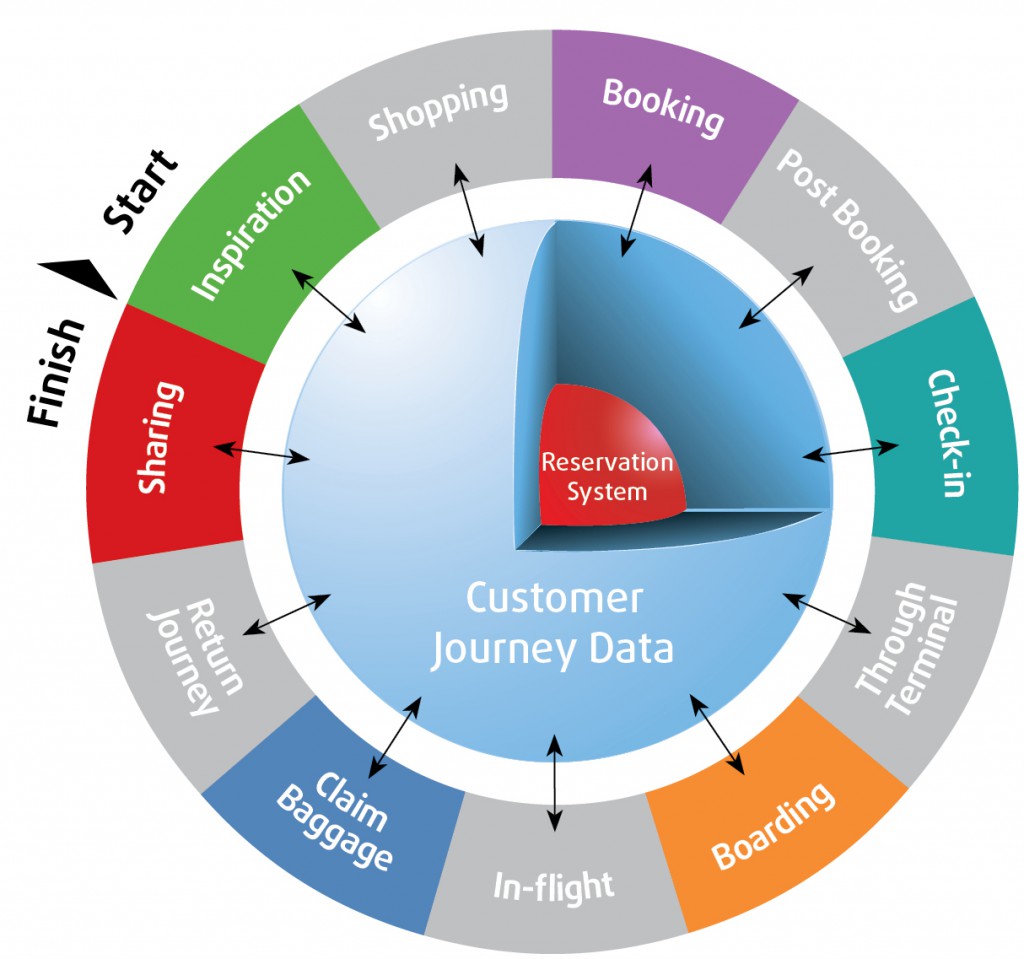Create Profitable Revenue While Earning True Loyalty
Sabre Airline Solutions has released a new whitepaper highlighting the business challenges faced by airlines in the areas of customer data, personalization, and retailing. Brand differentiation and customer-centric sales and service are becoming increasingly strategic areas for leading airlines due to their market share and profit potential. In the whitepaper, Sabre discusses the unique complexities in the industry, analyzes new findings about revenue potential and loyalty growth, and discusses possible solutions to these problems.
There is a belief that differentiation is only achievable through a massive shift in the level of service offered to all passengers, thus, separating oneself from the competition. However, an offering or experience can be differentiated to an individual customer without changing service for all customers. Each individual customer has a unique set of expectations for their interactions with an airline. Airlines have the ability to deliver a complete, consistent, personalized travel journey that meets or exceeds that unique set of expectations. This is only possible, however, if the airline is empowered with technology that provides an actionable record of a customer’s past and/or predicted preferences for sales and service interactions. This data-driven experience is Customer-Centric Airline Retailing.
 A new consumer reality has emerged, defined by an anywhere, anytime, any device expectation of accessibility and personalized engagement. To address this new state of persistent digital engagement, airlines need to develop a native level of fluency in mobile and social technologies, as well as better collaborate internally across groups that have traditionally worked separately from one another. No longer is customer engagement spoken of in terms of the traditional channel mentality: mobile, Web, agent, global distribution system and self-service. The past definition of channels does not accurately describe the new, homogenous cross-device experience of the customer. In the same way customers do not change their expectations based on their supposed acquisition channel, airlines should not treat the level of customer-experience provision any differently.
For a market-leading airline of the future, the primary differentiator will be offering connection, context and convenience in real time through any channel. Today, many mainstream retailers see omni-channel maturity as a key brand differentiator, with increased customer satisfaction, loyalty and brand perception highlighted as the top benefits. This explains why the chief marketing officer, not the chief information officer, vice president of e-commerce or other department head, is most often responsible for the strategy and execution of omni-channel initiatives. The primary reason for the rise to prominence of cross-device, full-journey engagement is due to the aforementioned shift in profitable revenue. In the past, yield and incremental bookings were the most significant focuses for an airline. While those are still vital activities to greater success, the value of the customer now stretches long past scheduling and booking conversions.
A new consumer reality has emerged, defined by an anywhere, anytime, any device expectation of accessibility and personalized engagement. To address this new state of persistent digital engagement, airlines need to develop a native level of fluency in mobile and social technologies, as well as better collaborate internally across groups that have traditionally worked separately from one another. No longer is customer engagement spoken of in terms of the traditional channel mentality: mobile, Web, agent, global distribution system and self-service. The past definition of channels does not accurately describe the new, homogenous cross-device experience of the customer. In the same way customers do not change their expectations based on their supposed acquisition channel, airlines should not treat the level of customer-experience provision any differently.
For a market-leading airline of the future, the primary differentiator will be offering connection, context and convenience in real time through any channel. Today, many mainstream retailers see omni-channel maturity as a key brand differentiator, with increased customer satisfaction, loyalty and brand perception highlighted as the top benefits. This explains why the chief marketing officer, not the chief information officer, vice president of e-commerce or other department head, is most often responsible for the strategy and execution of omni-channel initiatives. The primary reason for the rise to prominence of cross-device, full-journey engagement is due to the aforementioned shift in profitable revenue. In the past, yield and incremental bookings were the most significant focuses for an airline. While those are still vital activities to greater success, the value of the customer now stretches long past scheduling and booking conversions.
 A new consumer reality has emerged, defined by an anywhere, anytime, any device expectation of accessibility and personalized engagement. To address this new state of persistent digital engagement, airlines need to develop a native level of fluency in mobile and social technologies, as well as better collaborate internally across groups that have traditionally worked separately from one another. No longer is customer engagement spoken of in terms of the traditional channel mentality: mobile, Web, agent, global distribution system and self-service. The past definition of channels does not accurately describe the new, homogenous cross-device experience of the customer. In the same way customers do not change their expectations based on their supposed acquisition channel, airlines should not treat the level of customer-experience provision any differently.
For a market-leading airline of the future, the primary differentiator will be offering connection, context and convenience in real time through any channel. Today, many mainstream retailers see omni-channel maturity as a key brand differentiator, with increased customer satisfaction, loyalty and brand perception highlighted as the top benefits. This explains why the chief marketing officer, not the chief information officer, vice president of e-commerce or other department head, is most often responsible for the strategy and execution of omni-channel initiatives. The primary reason for the rise to prominence of cross-device, full-journey engagement is due to the aforementioned shift in profitable revenue. In the past, yield and incremental bookings were the most significant focuses for an airline. While those are still vital activities to greater success, the value of the customer now stretches long past scheduling and booking conversions.
A new consumer reality has emerged, defined by an anywhere, anytime, any device expectation of accessibility and personalized engagement. To address this new state of persistent digital engagement, airlines need to develop a native level of fluency in mobile and social technologies, as well as better collaborate internally across groups that have traditionally worked separately from one another. No longer is customer engagement spoken of in terms of the traditional channel mentality: mobile, Web, agent, global distribution system and self-service. The past definition of channels does not accurately describe the new, homogenous cross-device experience of the customer. In the same way customers do not change their expectations based on their supposed acquisition channel, airlines should not treat the level of customer-experience provision any differently.
For a market-leading airline of the future, the primary differentiator will be offering connection, context and convenience in real time through any channel. Today, many mainstream retailers see omni-channel maturity as a key brand differentiator, with increased customer satisfaction, loyalty and brand perception highlighted as the top benefits. This explains why the chief marketing officer, not the chief information officer, vice president of e-commerce or other department head, is most often responsible for the strategy and execution of omni-channel initiatives. The primary reason for the rise to prominence of cross-device, full-journey engagement is due to the aforementioned shift in profitable revenue. In the past, yield and incremental bookings were the most significant focuses for an airline. While those are still vital activities to greater success, the value of the customer now stretches long past scheduling and booking conversions.